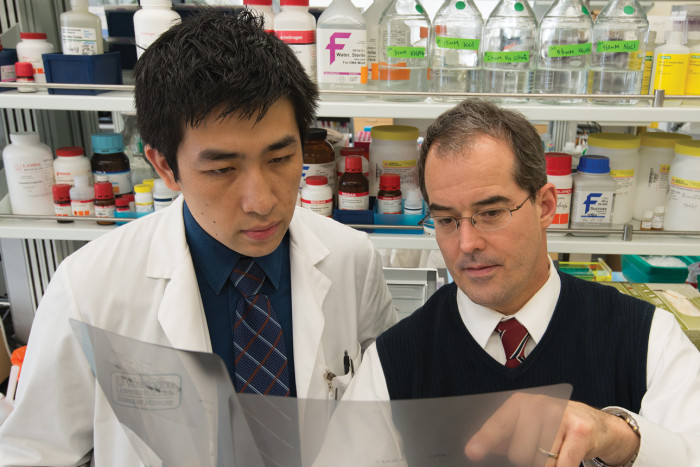Uncovering molecular pathways of urinary obstruction
Research at Washington University School of Medicine is clarifying the underlying causes of urinary obstruction with the goal of discovering new drug targets and treatments

Basic research by urologic surgeon Paul Austin, MD, right, surgery resident Joseph Song, MD, and colleagues is uncovering the molecular pathways involved in urinary obstruction.
Washington University pediatric urologist Paul Austin, MD, knows that treating infants and children with urinary obstructions can be challenging; a common problem, some obstructions can progress to kidney failure without surgery, but other obstructions resolve on their own.
Austin is working to advance the understanding of urinary obstruction through basic science research, which may one day provide the foundation for medical therapy to better treat the condition in children and adults.
“Dilation of the kidney is found in the fetus in one percent of all pregnancies,” says Austin, who works at St. Louis Children’s Hospital. “It doesn’t sound like much, but it actually is a lot of patients. About 20 to 30 percent of those cases are related to congenital defects in the urinary tract. These defects are responsible for about 25 percent of all pediatric kidney transplants, so it’s a pretty significant public health issue.”
Causes of obstruction
Some of the causes of obstruction are:
- blockage at the ureteropelvic junction (UPJ) where the ureter and renal pelvis meet
- blockage at the ureterovesical junction (UVJ) where the ureter meets the bladder
- kidney stones
- strictures
- blockage of the urethra
Children are generally followed with imaging unless they start to have problems such as urinary tract infections or pain. Surgery has a high success rate, but without good markers of disease or damage, it’s difficult to know when to intervene.
Austin and researcher Scott Manson, PhD, have explored the molecular pathways that lead to kidney fibrosis, or scarring, which stems from kidney obstruction. Early on they focused their research on BMP-7, a protein that is secreted by the kidney and prevents fibrosis. They have used a mouse model to show that administering BMP-7 helps the kidney recover from injuries related to obstruction, including fibrosis.
More recently, they have investigated ways to boost intrinsic production of BMP-7. In a mouse model and cell culture, they have restored production of BMP-7 by blocking the effect of histone deacetylase (HDAC), an enzyme which inhibits BMP-7 during kidney injury.
“When we administer BMP-7, that’s extrinsic—taking a pill or getting a shot,” says Austin. “But we also know that the kidney has an intrinsic production of BMP-7.” Blocking HDAC would be a way to turn on production intrinsically, or internally, he adds.
Austin and his lab have also looked at damage caused by obstruction according to the developmental stage in mice and the corresponding stage in humans. Fibrosis occurs in children and adults, but not in fetal kidneys. This means that treatment targets might vary for patients according to their stage of development.
Austin’s work is supported by an R01 National Institutes of Health (NIH) grant, but application of the lab’s findings ultimately may come from private drug development. “I think some of what we are doing in the lab is pretty feasible,” says Austin. “It’s just a matter of seeing where it takes us.”








